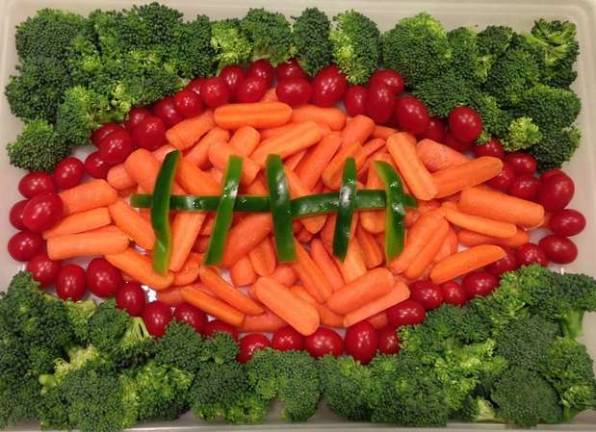Healthy snacks will keep your gang happy during the game and all year 'round

Are you one of the millions of Americans determined to adopt a healthier lifestyle and lose weight? Then you must develop a game plan for snacking during the football games now crowing your schedule. The season, which culminates in one of the worst eating days of the year, typically features menus that include beer, soft drinks, sandwiches, pizza, wings, potato chips, nachos and cheese sauce, potato salad and other fatty foods.
Whether you’re hosting a party or preparing food to take to someone else’s party, choose snacks that are minimally processed, high in fiber and low in fat and added sugars. This includes fruits, vegetables, whole grains, lean proteins (like white breast meat of poultry without skin, beans and seafood) and fat-free or low-fat milk and dairy products.
Think small plates
Small plates are a mealtime tradition among many Mediterranean countries, where a heart-healthy eating plan consists primarily of plant-based foods (fruits, vegetables, whole grains, beans, nuts, seeds, herbs and spices), and olive oil and canola oil replace butter, margarine and other unhealthy fats.You can eat less and save about half the calories. And small plate looks full so you don’t feel cheated.
Practice mindful eating
Eat slowly and take time to enjoy the taste and textures of foods. Pay attention to how you feel. Instead of mindlessly eating hundreds — even thousands — of calories while watching the football game, use hunger and fullness cues to recognize when you’ve had enough. Before going back for seconds, wait 20 minutes for your food to “settle.” It takes that long for your stomach to tell your brain that you’re full.Although it seems messy and unappetizing, you may want to let empty beverage containers, chicken bones, and other trash accumulate on the table to remind you of how much you have consumed. Researchers at Cornell University noted that people might eat and drink much more when there are no visual clues about how much they have consumed. Researchers also observed that people take less food from a smaller bowl.
Prepare healthier appetizers
Healthful snacking is part of a nutritious diet and may prevent overeating by maintaining your blood glucose levels. It starts with eating more vegetables and fruits, fat-free or low-fat milk and dairy products, and smaller portions of protein and grains. Half your plate should be fruits and vegetables, and the other half should be one-quarter lean protein and quarter whole grain. To learn more, see the sidebar and visit ChooseMyPlate.gov.Preparing food at home makes it easier to control what is in your snacks, but you don’t have to spend all day in the kitchen. Buy a variety of pre-cut vegetables and fruits and some low-fat dips, or make your own dips using fat-free or low-fat sour cream, mayonnaise or plain yogurt. The pre-made trays usually come with regular high-fat dip.
Sip smarter
What you drink is as important as what you eat, because beverages can easily add extra calories. Here are some tips to make better beverage choices.Drink water or other calorie-free beverages, as well as 100 percent juice. Sugar-sweetened soft drinks and other sweet drinks contain a lot of sugar and are high in calories.
When water just won’t do, enjoy the beverage of your choice, but cut back on the amount. Select a smaller cup, glass or can instead of a large or supersized option.
Alcohol contains almost as many calories per gram as fat does. It may increase your appetite, yet it reduces the number of fat calories you burn for energy. Research also shows that alcohol lowers testosterone levels for up to 24 hours after drinking.
If you drink beer, choose a light beer.
If you prefer a mixed drink, try cranberry juice with a splash of vodka, which is a lighter alcohol with fewer toxins.
Alternate alcoholic drinks with a glass of water. If you’ve had several drinks and the party isn’t at your house, it’s also a good idea to assign a designated driver or take a cab home.
Sources:
Clemson University Cooperative Extension Service: clemson.edu
U.S Department of Agriculture Center for Nutrition Policy and Promotion: ChooseMyPlate.gov